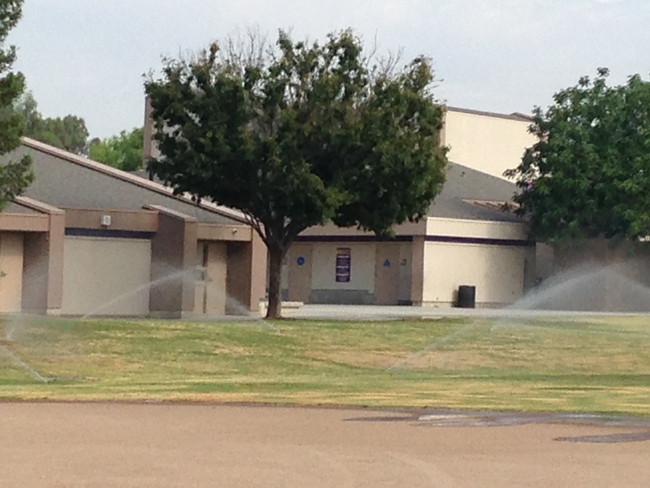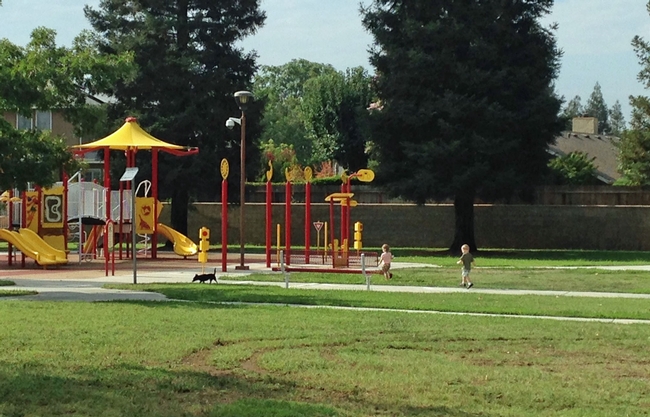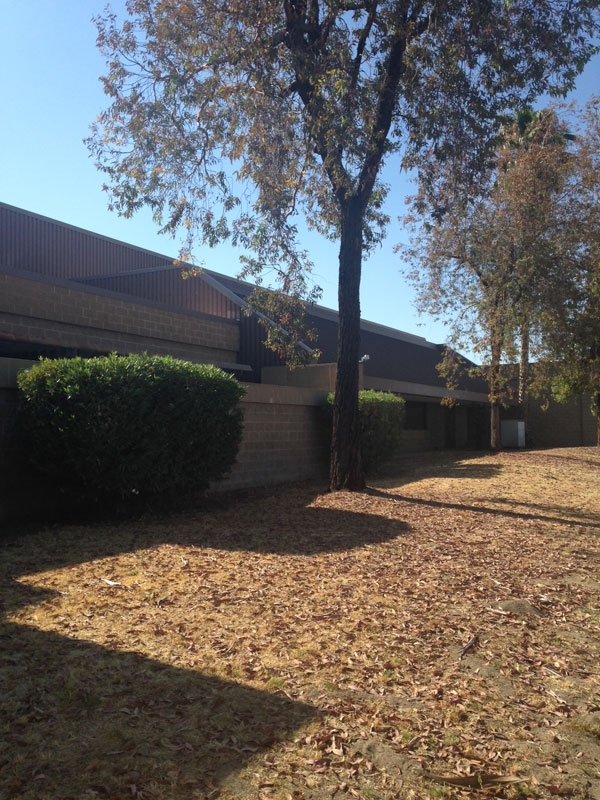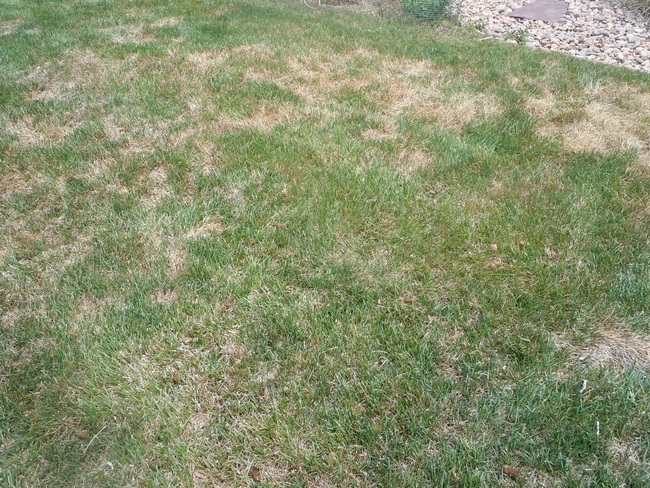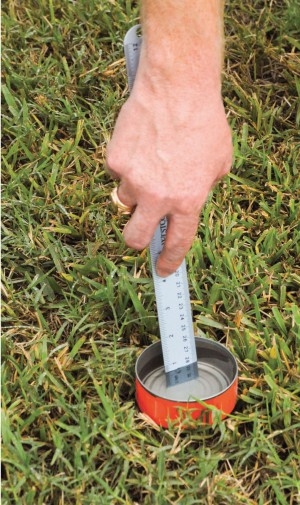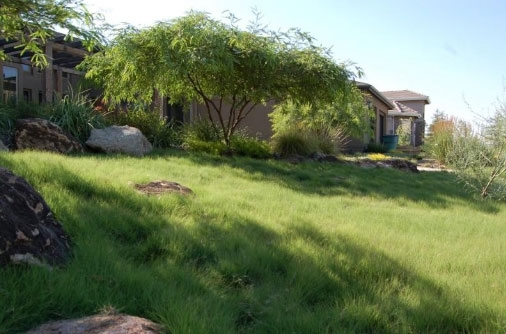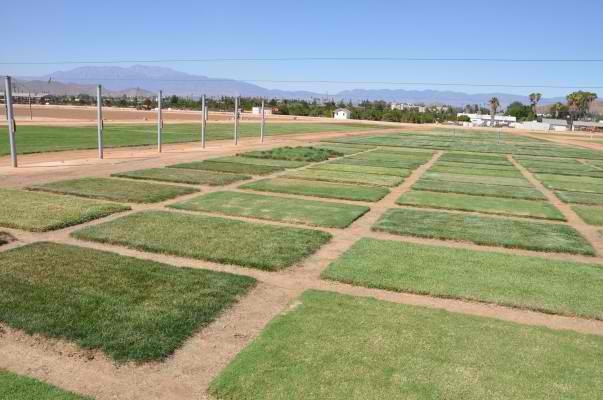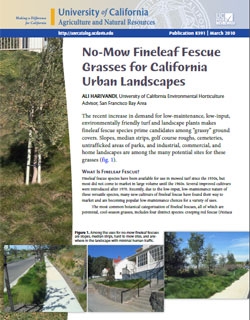Posts Tagged: turfgrass
Drought concerns causing unnecessary impact on landscapes and lawns
“Landscape plants and the water they use are under unrelenting attack,” says Don Hodel, UC ANR Cooperative Extension advisor in Los Angeles County. “But most of these attacks are misguided when one looks at the facts.”
Hodel and Dennis Pittenger, UC ANR Cooperative Extension area environmental horticulturist in the Department of Botany and Plant Sciences at UC Riverside, wrote a six-page commentary, 9%: The California Drought and Landscape Water Use, with facts about the relatively small amount of California's water that goes into landscapes, and the tremendous benefits to residents, communities and the environment provided by these plants. The article was published in PalmArbor, an electronic journal for the green industry.
“Landscape water use in California accounts for only 9 percent of total statewide water use,” the authors wrote. “Yes, that's right, just 9 percent. If we never watered another home or public landscape, park, sports field, or golf course in California, the state would save 9 percent of its total water consumption.”
Pittenger and Hodel named 12 ways lawns and landscape plants enhance the quality of Californians' lives and make urban areas more livable. Trees, shrubs, groundcovers, lawns and flowers provide:
- Oxygen
- Carbon sequestration to help mitigate global warming
- Rain capture, dust and erosion control
- Shade and energy savings in heating and cooling
- Wildlife habitat
- Food
- Beauty and ornament
- Recreation
- Enhanced property values
- Psychological well-being
- Cultural/historic value
- Jobs and economic value
The authors assert that California cannot conserve its way out of drought by trying to wring out significant water savings from the 9 percent that keeps landscapes alive.
Instead of shutting off the sprinklers, the authors call for “judicious irrigation,” providing just enough water to trees, plants and lawns to keep them alive. The authors believe judicious irrigation may be sufficient by itself to meet the 25 to 35 percent water reductions required by the state without changing the landscape to so-called “low-water use” or “drought-tolerant” plants.
“Most woody plants are actually drought-tolerant and low-water use once they are established and cared for properly,” the article says. “Research over the last 30 years has shown that water-reduction goals can be met while maintaining the quality-of-life benefits that landscape plants and functional lawns provide.”
Hodel and Pittenger also identified three urban water uses that should be considered priorities for outdoor irrigation, even in times of extreme water scarcity.
- Public parks, school play grounds and sports fields. “Children need to play and exercise on grass, not asphalt or dirt,” the article says. “And we all benefit from walking and exercising in a green, pastoral setting.”
- Bona fide botanical gardens and arboreta. “These research collections of plants have immense value,” the authors wrote. “For example, the plant collections at the world-famous San Diego Zoo actually have greater value than the animals.”
- Trees. “Mature trees are among the most valuable and difficult-to-replace plants in urban areas,” the UC ANR experts said. “Their loss would be devastating.
The director of UC ANR's California Institute for Water Resources, Doug Parker, is a spokesperson for the University of California on water issues of statewide importance. He agrees that, in much of the state, urban communities benefit from natural plantings and turf should be a priority for recreation areas.
“It's true that rock gardens, artificial turf and hardscape do not provide much wildlife habitat, carbon sequestration or environmental cooling,” he said. “But in places like Palm Springs, they are appropriate.”
Having worked closely with policymakers, scientists, government organizations and consumers during the past four years of drought, Parker said he has reached the conclusion that Californians cannot build or conserve their way out of periodic droughts.
“What we really need is a change in mindset to learn to live with drought and uncertainty,” Parker said.
Following are free water-conservation publications from UC ANR:
Water conservation tips for the home lawn and garden
By Pamela Geisel, UC ANR Cooperative Extension advisor emeritus
Carolyn Unruh, staff writer
Managing turfgrasses during drought
By Ali Harvandi, UC ANR Cooperative Extension advisor emeritus
Jaimes Baird, UC ANR Cooperative Extension turfgrass specialist, UC Riverside
Janet Hartin, UC ANR Cooperative Extension environmental horticulture advisor, San Bernardino County
The drought needs not be a death sentence for lawns
While a golden brown lawn is seen as a badge of honor to some residents of drought-stricken California, in fact, they are doing more harm to the environment than good, says UC Agriculture and Natural Resources turf expert Jim Baird.
“People have gone from one extreme to another,” said Baird, UC ANR Cooperative Extension turf specialist based at UC Riverside. “When we weren't in a water crisis, people were watering seven days a week, 365 days a year. Now, people feel like they're doing the right thing by putting no water on their lawn at all.”
Baird developed a keen appreciation for turf as a teenager playing golf and later working at a municipal golf course in Pueblo, Colo. “I found my passion,” he said. “The rest is history.” He earned a bachelor's degree in horticulture, a master's degree in agronomy, and a doctorate in botany, all the while focused on turf.
Baird's research and the lawn in front of his own Riverside home show that turf can be kept alive, and even attractive, with a minimal amount of water. And maintaining lawns rather than letting them die or replacing the grass with synthetic turf, concrete or so-called drought-tolerant plants offers important ecological services.
As anyone who has enjoyed a picnic in the park can attest, grass is cool. In contrast, the surface of artificial turf has been found to reach 180 degrees on a hot day. It often must be cooled with water before it can be used for sports. Bare soil, concrete and asphalt get significantly warmer and hold heat longer than a grassy lawn, which functions like a natural evaporative cooler.
“The more we let our grass lawns die or go away, the hotter it's going to get,” Baird said.
Grass, like all plants, absorbs carbon from the atmosphere and sequesters it in the soil, a vitally important quality as the country searches for ways to slow global warming. The production of plastics to make artificial turf has the opposite impact. And after a decade or so, artificial turf will wind up in the landfill, where it could take hundreds of years to decompose.
Grass provides food and habitat for birds and small mammals, with the abundant insects, spiders and worms living among the blades and below the surface. Unlike concrete, asphalt and hard-packed earth, properly maintained turfgrass is porous, allowing water to infiltrate when it does rain, rather than sheeting off the surface and into storm drains. Soil erosion and dust are also reduced or eliminated with grass lawns.
With all these benefits, Baird is dismayed to see the abundance of unnecessarily dead and dying lawns in California. The loss of green growing grass is an ecological loss in the short term, and difficult and expensive to revive once the drought ends.
“A dead lawn could come back as nothing but weeds,” Baird said.
He and his UC ANR colleagues wrote an eight-page publication on managing turfgrass under drought conditions that will help homeowners and lawn managers keep their lawns alive with minimal water.
The publication outlines the concept of deficit irrigation, a system in which the grass has just enough water to maintain an adequate appearance, but with less growth. Irrigation can be cut back to two times per week. If the blades spring back after being walked on, the lawn doesn't need more water.
“The grass may not be as lush and green as usual, but you can still have a lawn where kids and pets can play and families can enjoy outdoor barbecues,” Baird said.
Additional water savings can be achieved by carefully managing the sprinkler system. Areas shaded by trees or a house need less water than grass with day-long sun exposure. Irrigating before dawn reduces evaporation, leaving more water for the plant roots to absorb. Using sprinklers when there is less wind will help prevent overspray onto sidewalks and the street.
“We suggest homeowners test their sprinklers by placing cans around the lawn and running the sprinklers to see if water is being applied uniformly,” Baird said. “This also provides the opportunity for them to see if there are any broken sprinklers or leaks that need to be repaired.”
Mowing practices also impact the lawn's water use. The grass should be maintained at the tallest height recommended for the species being grown to encourage development of deep roots. Leaving the grass clippings on the lawn with a mulching mower will reduce evaporation from the soil surface.
If new lawns are being considered, water use can be cut by selecting a turfgrass species that uses less water. For example, Baird is studying kikuyugrass in plots at UC Riverside Turfgrass Research Facility. A native of East Africa, kikuyugrass is well adapted to warm, temperate climates in coastal areas and inland valleys of Southern and Central California. Other drought-tolerant grasses being studied at the facility are Bermudagrass and seashore paspalum.
A pdf version of Managing turfgrasses during drought, which includes grass species recommendations, is available for free download from the UC ANR online publication catalog.
For professional landscapers and home gardeners interested in detailed turfgrass research information, UC ANR is hosting a Turfgrass and Landscape Research Field Day Sept. 17. Registration is $90 before Aug. 28, $100 on or after Aug. 28 and $120 onsite. The complete agenda, registration form and previous research reports can be found on the field day website.
An initiative to improve California water quality, quantity and security is part of the UC Division of Agriculture and Natural Resources Strategic Vision 2025.
Author: Jeannette Warnert
Green going out of fashion in California
Many Californians are beginning to reluctantly accept that a well-manicured, lush green lawn is no longer a realistic landscape feature in the arid West, reported Steven Kurutz in the New York Times.
Chuck Ingels, UC Cooperative Extension advisor in Sacramento County, told the reporter homeowners with traditional green lawns may soon have no choice but to let them go brown. An average of 50 to 60 percent of a household's water consumption goes to outdoor use, which includes the landscape. He envisions a future in which lawns go dormant in winter and in summer, if watering is not allowed.
“The water bills are going up,” Ingels said. “I think we're going to start seeing more and more people opt for a brown lawn. I think it could become more traditional.”
If some water is available, there are less thirsty alternatives to traditional lawns that can provide a similar effect. Ingels has experimented with meadow-like buffalograss and dune sedge as alternatives. For example, UC Verde buffalograss, released in 2003, was bred for the California climate by UC researchers. It needs only infrequent mowing, uses half the water of tall fescue and is disease and pest resistant.
Other options are drought-tolerant native species like carex and bentgrass. These can be used for the meadow effect if not mowed, or mowed regularly for a more traditional look.
You can have a green landscape while conserving water
Turfgrass and landscape professionals will gather tomorrow, Sept. 13, at UC Riverside to learn about the latest innovations in turfgrass research and management. The 2012 Turfgrass and Landscape Research Field Day will start at 7 a.m.
One of the featured tour stops will be a research plot in which 18 plant species grown as landscape groundcovers are being evaluated for their ability to perform with low amounts of water. Dennis Pittenger, UC Cooperative Extension advisor for California’s Central Coast and South Region, and UC Cooperative Extension specialist Donald Merhaut, both based in the Department of Botany & Plant Sciences at UC Riverside, are conducting this study.
“Currently the plant materials are receiving about one-half the amount of water normally required by a tall fescue lawn, and all but three or four species appear to perform acceptably with this limited amount of water,” says Pittenger. “However, we will continue this treatment for another year to gain a full evaluation of these species' response to long-term limited irrigation.”
Residential water use totaled 5.9 million acre feet in 2005. California Assembly Bill 1881 resulted in California enacting an ordinance on January 1, 2010, reducing the evapotranspiration adjustment factor (ETAF) from 0.8 to 0.7 in new landscapes over 2,500 square feet.
David Fujino, executive director of the California Center for Urban Horticulture at UC Davis, Janet Hartin, UC Cooperative Extension advisor for San Bernardino and Los Angeles counties, and Loren Oki, UC Cooperative Extension specialist in the Department of Plant Sciences at UC Davis, received $450,000 from the California Department of Water Resources to reduce water waste and increase the landscape industry’s adoption of the new standard.
With the field assistance of William Baker and Associates, Fujino, Hartin and Oki, along with UC Cooperative Extension advisors Karrie Reid, Chuck Ingels, Mary Bianchi, and Darren Haver are setting up 30 large demonstration sites at publicly and commercially maintained landscape locations throughout the state that exemplify research-based best management practices. A variety of ornamental plants with varying evapotranspiration rates growing under a wide array of plant densities and microclimates are growing at the sites.
Demonstration sites can be seen at the following locations:
- Intel, Folsom
- Franchise Tax Board, Capitol Park, Sacramento,
- Stockton Golf and Country Club
- Woodbridge Golf and Country Club
- Fair Oaks Horticulture Center, Sacramento,
- Mission Oaks Parks and Recreation District, Sacramento
- City of Tracey
- University of California Santa Barbara
- City of Lakewood
- City of Murrieta
- City of Palm Desert
- Thunderbird Country Club, Rancho Mirage
- California Baptist University
- City of Santa Barbara
- City of Lompoc
At the field day, Hartin, an environmental horticulture expert, will talk about best management practices that large public and private landscape and irrigation managers can implement to meet the 0.7 ETAF for landscapes over 2,500 square feet.
Specific practices that she will discuss include hydrozoning (placing plants with similar water needs together), irrigation scheduling based on water requirements of the various zones, optimizing sprinkler system distribution uniformity, drip irrigation when appropriate, weed control and proper use of soil amendments and mulch.
The event will be held at the university’s Turfgrass Research Facility at 1060 Martin Luther King Blvd. in Riverside.
“With the addition of new research areas, UCR now has a state-of-the-art, second-to-none facility to study irrigation and salinity effects on turfgrass and landscape plants,” says James Baird, a UC Cooperative Extension specialist in the Department of Botany and Plant Sciences at UC Riverside, who is leading the field day. “UCR is addressing the challenges of maintaining turf and landscape plants with diminishing water resources by identifying: drought tolerance among new and existing germplasm; commercial products that help save water; and best management practices using recycled and alternate water sources for irrigation.”
Registration for the field day costs $100, which includes lunch. To register, view the agenda or get directions for tomorrow’s field day, go to http://ucanr.org/sites/turfgrassfieldday.
No-mow fineleaf fescue grasses for California urban landscapes
Due to their low-maintenance, low-input, environmentally friendly features, fineleaf fescue species are becoming increasingly popular choices in urban landscapes.
All species of fineleaf fescues are perennial, cool-season grasses. Potential sites for these grasses include: slopes, median strips, golf course roughs, cemeteries, untrafficked areas of parks, and industrial, commercial and home landscapes.
The UC publication No-Mow Fineleaf Fescue Grasses for California Urban Landscapes provides information beneficial to those who have fineleaf fescue on their property and those considering using it.
Topics include:
- What is fineleaf fescue
- Performance evaluation
- Sodding research,
- Selecting species and cultivars
- Establishment
- Irrigation
- Fertilization
- Weed control
- Disease management
- And more


